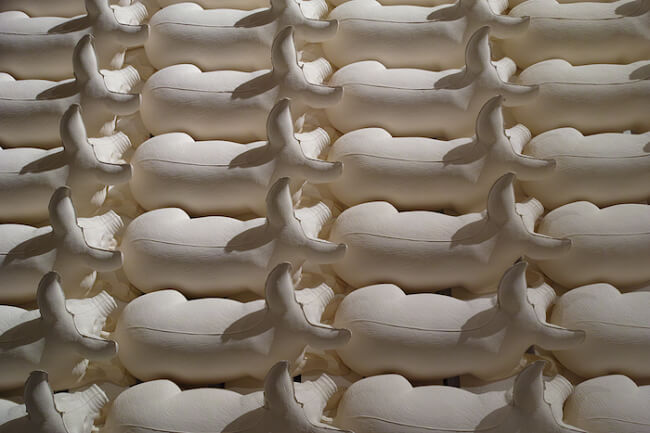Every day, a man wearing a Swiss Army backpack enters the largest gallery at the Santa Cruz Museum of Art & History and smashes a ceramic animal on a gold-leafed pedestal.
In a provocative new installation, Is It Necessary?, at the Santa Cruz Museum of Art & History, sculptor Rocky Lewycky questions the brutality and uniformity of factory farming in the United States. Is It Necessary? blends sculpture, repetition, and ritual performance— all signatures of Lewycky’s work— in a political presentation. The result is an installation that reflects Lewycky’s evolving voice as an artist and social activist.
Celebrated for his ceramic work and use of repetitive forms, Lewycky’s projects have increasingly shifted to focus on social consciousness and audience participation. His work frequently invites viewers to become participants in a communal process.
“My artwork is continuously shedding its skin, morphing through new mediums that convey ideas of time and transformation,” Lewycky states. “Process is often a key entry point into my artistic expression, as demonstrated by mark-making and repetition of form.”
We can see a sense of scale at work with Lewycky’s use of repetition in the exhibit. The rows open rows of neatly-arranged ceramic animals are analogous to animals within mass factory farming and fishing operations. In the exhibition they’re identical, commodities instead of living things. This is a view of our meat supply that many people never fully comprehend. As a society, we often do not encounter our food until it’s packaged and sold to us at the supermarket. Most people never see, if you could forgive a sick joke in this case, how the sausage gets made. Occasionally an undercover activist will infiltrate one of these farming operations and shoot some gut-churning amateur video of animals being abused, suffering from disease or living in foul, unsanitary metal pens. This form of activism is often opposed by federal law enforcement agencies or so-called “Ag Gag” laws. These videos can be as powerful as they are nauseating, but given the increasing pressure against this form of activism it seems appropriate for Lewycky to work toward a similar goal by using his art as a proxy.
Lewycky’s ritualized, almost indifferent (note his expressionless face in the photograph included in this post) destruction of the pieces suggests a factory floor killing process. What is it like to be a worker in one of these industries? How does regimented, quota-filling killing change a person?
“Is It Necessary? distills emotional, political, and spiritual activism into a powerful aesthetic statement,” museum executive director Nina Simon said. “Lewycky’s careful attention to form and process creates a result that is both shocking and delicate. While the installation is overtly political, the performance of the smashing of the animals feels deeply personal. It imagines a transformation of our relationship with animals from uniform brutality to something holy and humane.”
Is It Necessary? is on display at the Santa Cruz Museum of Art & History through Sunday, February 23. On that date, Lewycky will “liberate” ceramic animals that have not been smashed as gifts to individuals who make donations to the Humane Farming Association.
Bill Rodgers is a Contributing Editor at CFile.
Above image: Installation shots from Rocky Lewycky’s Is It Necessary? at the Santa Cruz Museum of Art & History. The installation runs until February 23.










Installation shots from Rocky Lewycky’s Is It Necessary? at the Santa Cruz Museum of Art & History. The installation runs until February 23.

Artist Rocky Lewycky pictured mid-destruction of one of his pieces from Is It Necessary? at the Santa Cruz Museum of Art & History. Lewycky is a recipient of the Rydell Visual Arts Fellowship.
Visit the Santa Cruz Museum of Art & History

what a great visual way to draw attention to the horrors of factory farming. as human animals we acknowledge death to be one of the scariest and most emotionally/physically painful experiences we have to go through on earth, yet we kill over 150 billion other animals every year without a thought – just to eat. it’s nice to see someone devote so much time and hard work to honor and draw attention to creatures who are routinely tortured and killed. amazing work of art!